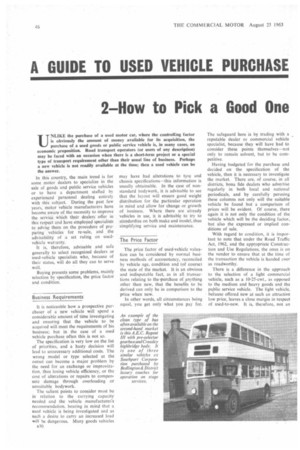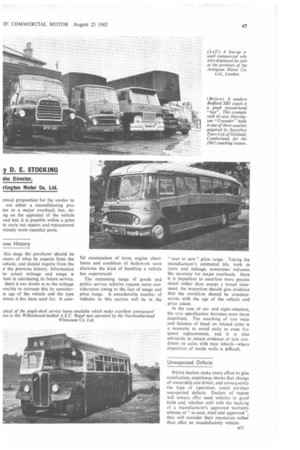A GUIDE TO USED VEHICLE PURCHASE 2—How to Pick a Good One
Page 48

Page 49

If you've noticed an error in this article please click here to report it so we can fix it.
-u NLIKE the purchase of a used motor car, where the controlling factor is obviously the amount of money available for its acquisition, the purchase of a used goods or public service vehicle is, in many cases, an economic proposition. Road transport operators (or users of any description) may be faced with an occasion when there is a short-term project or a special type of transport requirement other than their usual line of business. Perhaps a new vehicle is not readily available at the time; then a used vehicle can be the answer.
In this country, the main trend is for some motor dealers to specialize in the sale of goods and public service vehicles or to have a department staffed by experienced personnel dealing entirely with this subject. During the past few years, motor vehicle manufacturers have become aware of the necessity to improve the service which their dealers offer in this respect and have employed specialists to advise them on the procedure of preparing vehicles for re-sale, and _ the advisability of a set ruling on usedvehicle warranty.
It is, therefore, advisable and safe generally to select recognized dealers or used-vehicle specialists who, because of their status, will do all they can to serve well.
Buying presents some problems, mainly selection by specification, the price factor and condition.
Business Requirements It is noticeable how a prospective purchaser of a new vehicle will spend a considerable amount of time investigating and ensuring that the vehicle to be acquired will meet the requirements of his business; but in the case of a used vehicle purchase often this is not so.
The specification is very low on the list of priorities, and a hasty decision will lead to unnecessary additional costs. The wrong model or type selected at the outset can become a major problem by the need for an exchange or improvization, thus losing vehicle efficiency, or the cost of alterations or repairs to compensate damage through overloading or unsuitable bodywork.
The salient points to consider must he in relation to the carrying capacity needed and the vehicle manufacturers recommendation, bearing in mind that a used vehicle is being investigated and as such a desire to carry an increased load will be dangerous. Many goods vehicles may have had alterations to tyre and chassis specifications—this information is usually obtainable. In the case of nonstandard bodywork, it is advisable to see that the layout will ensure good weight distribution for the particular operation in mind and allow for change or growth of business. Where there are already vehicles in use, it is advisable to try to standardize on both make and model, thus simplifying service and maintenance.
The Price Factor The price factor of used-vehicle valuation can be considered by normal business methods of accountancy, reconciled by vehicle age, condition and (of course) the state of the market. It is an obvious and indisputable fact, as in all transac• tions relating to the-purchase of anything other than new, that the benefits to be derived can only be in comparison to the price when new.
In other words, all circumstances being equal, you get only what you pay for. The safeguard here is by trading with a reputable dealer or commercial vehicle specialist, because they will have had to consider these points themselves—not only to remain solvent, but to be competitive.
Having budgeted for the purchase and decided on the specification of the vehicle, then it is necessary to investigate thc market. There are, of course, in all districts, bona fide dealers who advertise regularly in both local and national periodicals, and by carefully perusing these columns not only will the suitable vehicle be found but a comparison of prices will be evident. Of course, there again it is not only the condition of the vehicle which will be the deciding factor, but also the expressed or implied conditions of sale.
With regard to condition, it is important to note that under the Road Traffic Act, 1962, and the appropriate Construction and Use Regulations, the onus is on the vendor to ensure that at the time of the transaction the vehicle is handed over as roadworthy.
There is a difference in the approach to the selection of a light commercial vehicle, such as a 10-25-cwt., as opposed to the medium and heavy goods and the public service vehicle. The light vehicle, bebuse offered new at such an attractive low price, leaves a close margin in respect of used-to-new. It is, therefore, not an
y D. E. STOCKING ties Director,
rlington Motor Co. Ltd.
)mical proposition for the vendor to out either a reconditioning prome or a major overhaul; but, deng on the appraisal of the vehicle oad test, it is possible within a price to carry out repairs and replacement viously worn essential parts.
boos History
this stage the purchaser should be aware of what be expects from the vehicle, and should inquire from the ir the previous history. Information he actual mileage and usage is 'tant in calculating its future service. there is any doubt as to the mileage ossible to estimate this by considerle age of the vehicle and the type siness it has been used for. A care
ful examination of tyres, engine cleanliness and condition of bodywork soon discloses the kind of handling a vehicle has experienced.
The remaining range of goods and public service vehicles require more consideration owing to the fact of usage and price range. A considerable number of vehicles in this section will be in the "near to new" price range. Taking the manufacturer's estimated life, both in years and mileage, sometimes indicates the necessity for major overhauls. Here it is important to ascertain more precise detail rather than accept a broad statement An inspection should give evidence that the condition should be commensurate with the age of the vehicle and price asked.
In the case of sixand eight-wheelers, the tyre specification becomes even more important. The matching of tyre wear and balance of tread on related axles is a necessity to avoid early or even frequent replacements, and it is also advisable to obtain evidence of tyre condition on axles with twin wheels—where inspection of inside walls is difficult.
Unexpected Defects Whilst dealers make every effort to give satisfaction, experience shows that change of ownership and driver, and consequently the type of operation, could produce unexpected defects. Dealers of repute will always offer used vehicles in good faith and, whether sold with the backing of a manufacturer's approved warranty scheme or "as seen, tried and approved '', they will consider their reputation rather than offer an unsatisfactory vehicle.




































































































